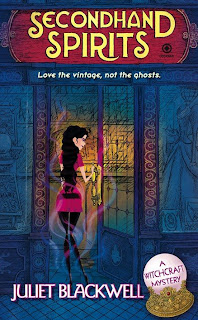
I'd like to welcome Hailey Lind aka Juliet Blackwell aka Julie, President of NorCal Sisters in Crime as our guest today! This intro should have gone up with the post, but my computer started making ghastly noises yesterday, so I backed everything up and hastily shut it off. As a result, no intro this morning when the post went up! I'm happy to say the noises were caused by cat hair in the MacBook's fan - the Genius at the Apple Store shot compressed air through it and POOF! Out came a big old wad of fur. I am shocked, I tells ya! Anyway, please welcome the lovely and talented Julie/Hailey/Juliet!
I was at a book reading the other day listening to two author friends, Eric Stone and Tim Maleeny. Eric was talking about his series set in China and Hong Kong, based upon true stories that he gathered while there as a journalist. Fascinating stuff. But then, as an aside, he happened to mention that Chinese vampires hold their arms out stiffly in front of them, and hop.
Wait.
What? They hold their arms out like mummies, and hop? That’s the coolest thing I’ve ever heard! I know that there’s a Mexican type of vampire that is sort of a cross between werewolf and vampire, the terrifying chupacabras. The Chinese version sounds like a cross between a ghoul and a vampire. I can just see a new blockbuster movie trilogy: The Ethnic Vampire Wars.
But it’s really the hopping I find most enthralling. Plus, upon further inquiry one learns that the Chinese vampire fighter’s arsenal does not include stakes. Instead, you can zap the fearsome creature by writing a symbol on a piece of yellow paper and sticking it to his forehead. And, if you throw uncooked rice at it, or –why stop there?-- set a whole bag by the door, your average Chinese vampire feels compelled to pause in its ghastly pursuit of blood, and count each and every grain of rice.
 This got me thinking about how folkloric traditions vary from culture to culture, even when they start out with a lot in common (this is the way my mind works -- I used to be an anthropologist). When I set about writing my new Witchcraft mysteries (Secondhand Spirits, the first in the series, will be released from Obsidian July 7), I was determined to take the Witchcraft seriously, and for the idea of witches to make sense historically and culturally.
This got me thinking about how folkloric traditions vary from culture to culture, even when they start out with a lot in common (this is the way my mind works -- I used to be an anthropologist). When I set about writing my new Witchcraft mysteries (Secondhand Spirits, the first in the series, will be released from Obsidian July 7), I was determined to take the Witchcraft seriously, and for the idea of witches to make sense historically and culturally.
What do I mean by that? When I set out to write a Witchcraft book, I decided, first and foremost, not to allow anyone to think that I was revisiting .jpg) “Bewitched”. I’ll confess it was one of my favorite shows when I was a child…but it truly butchered the real history and cultural traditions of witches, whether European or otherwise.
“Bewitched”. I’ll confess it was one of my favorite shows when I was a child…but it truly butchered the real history and cultural traditions of witches, whether European or otherwise.
My protagonist, Lily Ivory, comes from a small town in  what they are, a powerful curandera might also be feared and despised, and re-labeled a bruja, or witch. They are often believed to have a Nagual, a type of nocturnal familiar that sneaks around town while they are asleep, keeping an eye on people, for good or for ill.
what they are, a powerful curandera might also be feared and despised, and re-labeled a bruja, or witch. They are often believed to have a Nagual, a type of nocturnal familiar that sneaks around town while they are asleep, keeping an eye on people, for good or for ill.
I may not be a practicing witch myself, but I respect the tradition(s). I revere the weight of history; the strength of folklore as a manifestation of communal angst and desire; and the awe-inspiring power of nature. And when it comes right down to it, I’m open to the idea that there is much more unknown than known in our world.
There are witch traditions all over the world –just as there are vampire traditions. The majority of us in the
Now, if I could just come up with a way to include hopping vampires in the storyline, I’d be all set. Or would that be too over the top?
 Juliet Blackwell, aka Hailey Lind, is the pseudonym for a mystery author who, together with her sister, wrote the Art Lover's Mystery Series—including the Agatha-nominated Feint of Art and the IMBA bestsellers Shooting Gallery and Brush with Death. The fourth in the series, Arsenic and Old Paint, will be released in fall, 2010. Juliet's new paranormal Witchcraft Mystery series begins with Secondhand Spirits (July, 2009), about a witch with a vintage clothing store in the Haight-Ashbury neighborhood of
Juliet Blackwell, aka Hailey Lind, is the pseudonym for a mystery author who, together with her sister, wrote the Art Lover's Mystery Series—including the Agatha-nominated Feint of Art and the IMBA bestsellers Shooting Gallery and Brush with Death. The fourth in the series, Arsenic and Old Paint, will be released in fall, 2010. Juliet's new paranormal Witchcraft Mystery series begins with Secondhand Spirits (July, 2009), about a witch with a vintage clothing store in the Haight-Ashbury neighborhood of
A former anthropologist and social worker, Juliet has worked in



